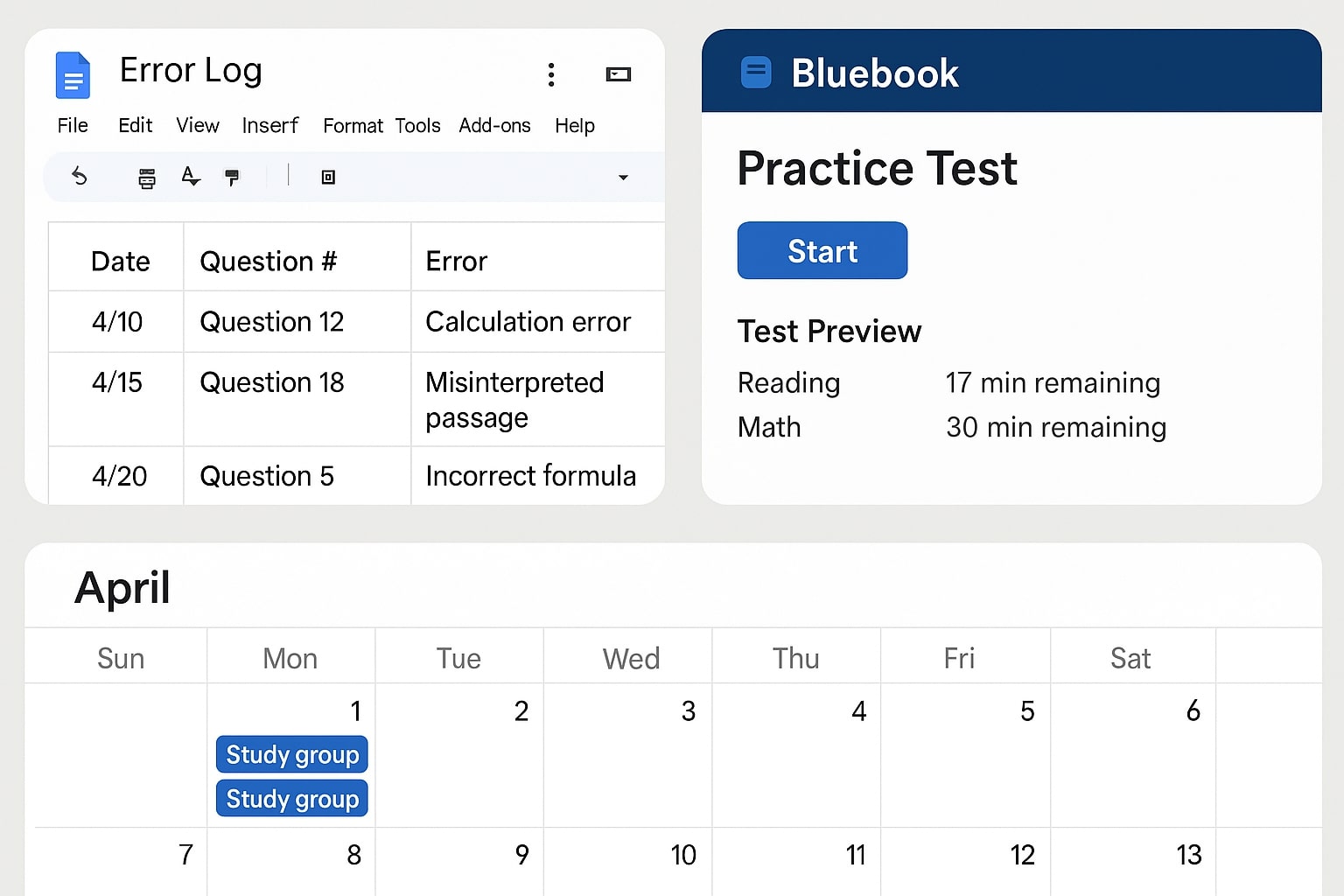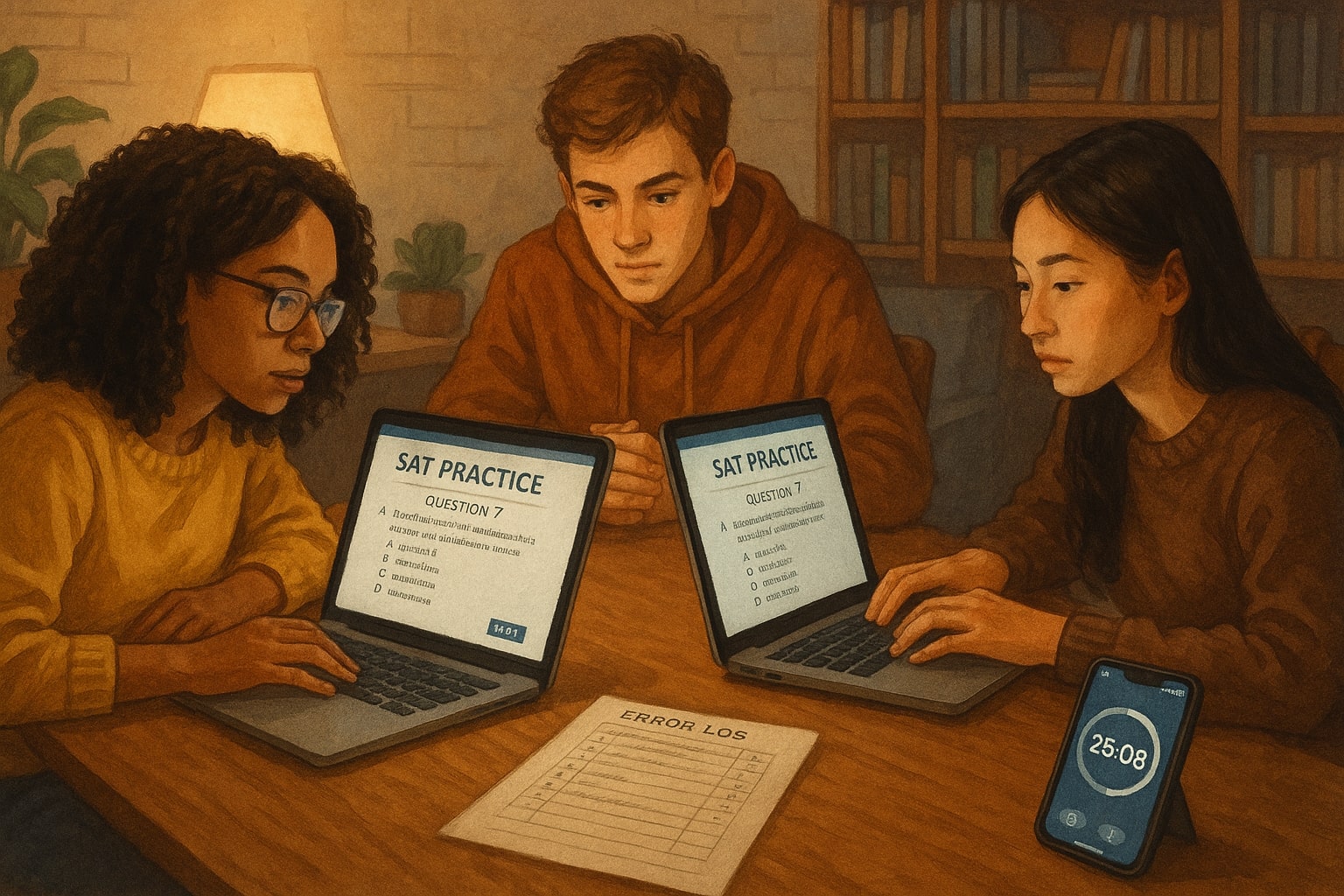Why studying with friends can be magical—and tricky
Studying for the Digital SAT with friends can feel like the perfect mix of motivation and accountability. You share resources, compare notes, swap strategies, and turn lonely hours into something social and energizing. But let’s be honest: a group can also turn into a group chat, a meme-sharing session, or a pizza party that conveniently forgets to open the textbooks.
If you want the best of both worlds—supportive, energizing study time that actually moves your score needle—this guide will show you how to plan SAT study sessions with friends without getting distracted. We’ll cover practical structures, small rituals that boost focus, roles to assign, a sample weekly plan, and even a simple table you can print or screenshot to keep everyone on the same page. Along the way I’ll weave in examples and real-world tips so you and your study crew leave each session smarter and more confident.
Start with a shared purpose
Every effective group session begins with a clear why. If you and your friends don’t agree on the purpose, different expectations will pull the group in opposing directions.
How to define a clear purpose
- Pick a measurable goal: “Complete one practice section and review mistakes” beats “study math.”
- Set a target score or skill target for the month: “Gain 40 points on Math” or “reduce careless errors in Evidence-Based Reading.”
- Decide the session type: practice test, pacing drills, concept review, or strategy workshop.
Example: Instead of saying ‘study together Sunday,’ try: ‘Sunday 3–6pm: full Reading & Writing practice section in Bluebook, then 45 minutes reviewing missed questions and summarizing three common error types.’
Build a simple, inviting structure
Structure is your friend—particularly in a social setting. A predictable rhythm reduces decision fatigue and keeps energy high.
A reliable session template (90–120 minutes)
- 5–10 minutes: quick check-in and goal announcement.
- 5 minutes: warm-up drill (brain stretch—mental math, quick vocab, or editing sentence correction).
- 45–60 minutes: focused work block (individual or paired, depending on the task).
- 10–15 minutes: short break (snacks, stretch, 5-minute walk—no phones!).
- 25–30 minutes: review and teach-back—discuss answers, explain reasoning, and summarize mistakes.
- 5 minutes: commit to one action before next session (e.g., practice 20 released problems, watch one Khan Academy video, schedule a Bluebook practice test).
This template keeps the session moving and ensures everyone is invested in the outcome. The review and teach-back segment is especially powerful: explaining concepts to peers cements your own understanding.
Assign friendly roles to keep momentum
Roles are not about hierarchy—they’re practical. Rotating responsibilities give every member ownership and reduces distractions.
Example roles
- Host/Timekeeper: Starts the session, keeps time, and enforces break windows.
- Question Captain: Picks practice questions or sections and organizes transitions.
- Explanation Lead: Facilitates the review portion and calls on members to explain answers.
- Tech & Resources Manager: Loads Bluebook practice, shares screens, or pulls up Khan Academy items.
- Motivation Buddy: Celebrates wins and checks in on morale—mental prep matters.
Rotate these roles every session. It keeps things fair and helps everyone build complementary skills: leadership, time management, and teaching.
Create rules that protect your focus—without killing the vibe
Rules should be short, agreed-upon, and easy to enforce.
Sample focus rules
- Phones on airplane mode or in a designated basket during work blocks.
- Use the Pomodoro technique: 25 minutes work, 5 minutes break (or adapt to 45/15 for longer stretches).
- One conversation at a time—if you want a side chat, take it during the break.
- Bring a specific deliverable: practice test printout, laptop with Bluebook installed, or problem set.
Tip: Keep rules positive and simple. Replace “no talking” with “quiet focus for work blocks.” Framing matters: people respond better to encouraging guidelines than to strict bans.
Plan what you’ll practice—and why
Random practice is sympathic but inefficient. Align your study choices with your goals: score targets, weak areas, or timing problems.
Choosing the right practice for the session
- Strategy session: timed sections focused on pacing and question approach (great before a test date).
- Deep-dive session: choose one topic like algebra or command of evidence and work problems until you can teach someone else how to solve them.
- Mixed practice: short blocks of Reading, Writing, and Math to build stamina and adaptability.
- Full practice test: mimic test day in Bluebook and strictly recreate test conditions.
Rotate these session types weekly so you don’t plateau. If you’re using Bluebook or College Board practice, make sure everyone knows how digital adaptive testing changes question experience—shorter test, different pacing, and built-in calculator for some questions—which should inform your practice choices.
Use the right tools, and use them well
Good tools make productive sessions effortless. For the Digital SAT, Bluebook practice tests are essential; combine them with Khan Academy practice, a shared document, and a simple timer app.
Essential tools
- Bluebook app for full-length digital practice and previews.
- Khan Academy for personalized practice and video lessons tied to SAT content.
- Shared Google Doc or collaborative notes for error logs and patterns.
- Timer app (Pomodoro or simple countdown) to enforce work/break blocks.
When you bring these tools into the study session, decide who runs each tool so you avoid time wasted on technical hiccups. The Tech & Resources Manager role helps here.
Make mistakes your study gold
Every error is useful if you treat it like data. Instead of glossing over wrong answers, use them to inform what you practice next.
How to build a shared error log
- Open a simple table in your shared document for: question, mistake type (calculation, misread, timing, concept), correct approach, and action item.
- At the end of each group session, each person adds 1–3 mistakes they made and a short plan to fix them (e.g., “review linear equation strategies; redo 10 problems on slope”).
- Review last session’s action items at the start of the next one.
Sample weekly plan for a busy student group
This sample assumes a moderate weekly commitment: four sessions totaling about 6–8 hours. Adapt it to your team’s schedule.
| Day | Session Type | Duration | Goal |
|---|---|---|---|
| Monday | Short focus (Math) | 60 min | Target algebra weaknesses; 20 practice problems |
| Wednesday | Reading & Writing mixed blocks | 90 min | Pace drill + review 15 tough passages |
| Friday | Strategy workshop | 60–90 min | Teach-back: explain grammar rules and passage annotation strategies |
| Sunday | Full practice simulation (Bluebook) | 3–3.5 hrs | Simulate test day; full review afterward |
Use Sunday’s simulation to identify pacing leaks and emotional triggers (test-day anxiety, impulse skipping). The rest of the week is designed to target those leaks.
When to study together—and when to go solo
Group sessions are great for motivation, explanation, and accountability. But some tasks are more effective alone: targeted practice on a personal weak spot, intense timed sections where you need complete silence, or reviewing personalized feedback.
Guidelines to decide
- Do together: concept clarifications, teach-backs, timed group drills, and full simulations.
- Do alone: official practice tests when you need accurate baseline scores, deep concept remediation, and tailored practice plans based on error logs.
Humans learn differently. Mix group energy with responsible solo refinement to maximize growth.
Keep accountability kind and motivating
Homework that feels like punishment becomes easy to dodge. Instead, make accountability motivating.
Ideas for positive accountability
- Micro-commitments: everyone posts one small, achievable action they’ll do before the next session.
- Scoreboard of small wins: track practice sections completed or consecutive distraction-free sessions and celebrate often.
- Study contracts: a short, fun pact that everyone signs—a commitment to focus, show up, and be honest about distraction.
These rituals build psychological safety—members feel supported, not policed.
Handling common distractions without drama
Distractions happen. The trick is to handle them quickly and return to work without resentment.
Quick distraction protocol (the 3-step reset)
- Acknowledge: one sentence—”Oops, I checked my phone; I’m back.”
- Refocus: do a 60-second breathing or stretch reset.
- Reconnect: re-state your goal for the next block aloud or in chat.
This protocol normalizes slips without allowing them to derail the session. Small, repeated resets will preserve the group’s momentum.
When group study isn’t enough: consider expert guidance
Studying with friends is powerful, but targeted guidance can accelerate progress, especially if your group hits a plateau or you want tailored strategies.
Sparkl’s personalized tutoring can fit naturally into a group-friendly prep plan: you can keep regular sessions with friends for practice and drills, and bring in an expert for targeted lessons, 1-on-1 guidance, tailored study plans, and AI-driven insights that reveal patterns you might miss. A few sessions with a skilled tutor can help your group refine technique, fix recurring mistake types, and design smarter practice routines.
Practical example: a distraction-free session in action
Here’s a realistic walkthrough of how a 2-hour session might flow when the group follows the template and roles.
- 3:00–3:05 pm: Host welcomes the group. Quick check-in: each person posts their single goal for the session.
- 3:05–3:10 pm: Warm-up: 5 mental math problems timed at 60 seconds each.
- 3:10–3:55 pm: Focused block: everyone does a 45-minute Math section in Bluebook with phones in a basket.
- 3:55–4:05 pm: Break. 10 minutes to stretch, hydrate, and quickly chat—no phones until the five-minute mark.
- 4:05–4:30 pm: Review: Explanation Lead facilitates discussion. Each person explains one problem they missed.
- 4:30–4:50 pm: Mini-teach: two volunteers explain a strategy (e.g., split-point reading for evidence questions) while others take notes.
- 4:50–4:55 pm: Action items: everyone commits to one focused practice item before next session.
Because roles were assigned and rules were clear, the session moves efficiently: learning, review, and accountability all happen without friction.
Measuring progress without obsession
Scores matter, but they’re not the only measure of growth. Use a mix of quantitative and qualitative metrics.
Metrics to track
- Quantitative: Bluebook practice scores, percent correct on timed sections, reduction in question-level mistakes.
- Qualitative: confidence on specific question types, ability to explain solutions aloud, improved timing comfort.
- Process measures: number of distraction-free sessions completed, consistency of error log updates.
Celebrate both numeric improvement and softer gains. Explaining a previously confusing problem to a friend is progress worth acknowledging.
Keep it fun—and sustainable
Routine beats intensity. It’s better to study a little consistently with friends than to cram a lot sporadically. Add small rituals that keep morale high: a playlist for focus, a snack rotation, or a five-minute post-session laugh where everyone shares the funniest test-day anecdote.
Small pleasures make discipline easier.
One-week challenge to get started
Try this rapid experiment to see how group study transforms your prep:
- Day 1: Define goals and roles for the week; create a shared error log.
- Days 2–4: Run 60–90 minute focused sessions following the template above.
- Day 5: Solo practice—each member takes a 45-minute timed section and uploads results to the shared log.
- Day 7: Full group review of the week’s errors and commit to a 2-week improvement plan.
At the end of the week, evaluate: Did distraction rates fall? Did you finish assigned work? Are action items being completed? Use those answers to refine your approach.

Final checklist: Make your next session better than the last
- Clear session purpose and measurable goal.
- Assigned roles and quick rotation plan.
- Shared error log and one action item per person.
- Strict but friendly focus rules and a distraction reset protocol.
- At least one simulation in Bluebook every 1–2 weeks.
- Consider occasional expert sessions (like Sparkl’s personalized tutoring) if you need targeted strategy or score acceleration.
Parting thought: Your group is a team, not a crutch
Study groups are powerful because they mix accountability, explanation, and encouragement. When planned thoughtfully, they amplify your individual abilities and make the long slog of SAT prep less lonely and more effective. Be curious together, be kind together, and treat every mistake as an opportunity the whole group can learn from.
If you ever feel stuck, a few targeted tutoring sessions—tailored study plans, one-on-one guidance, and data-driven insights—can give your group the techniques and confidence to unlock faster progress. But the core truth is simple: clear goals, agreed structure, and a little discipline make group study a secret weapon. Start small, iterate often, and celebrate progress—together.















No Comments
Leave a comment Cancel